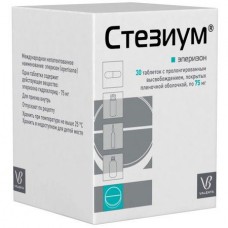Expiration date: 06/2026
Method of administration and dosage
Always take the drug in full accordance with the recommendations of your doctor. If in doubt, consult your doctor.
Recommended dose
The usual dose for adults is 1 tablet twice a day after meals. The dose can be adjusted by your doctor depending on your age and symptoms.
Route and (or) method of administration
Inside. Take whole, do not break or chew.
Duration of therapy
The duration of therapy is determined by the doctor and depends on the severity of the disorders and the therapeutic effect.
If you forgot to take the drug Stezium®
If you forget to take the drug on time, skip this dose and take the next one at the scheduled time. Do not take a double dose to compensate for a missed dose. Instead, wait for the time of the next drug intake.
If you have any questions about the use of the drug, contact your doctor.
Indications
The drug Stezium® is indicated for use in adults over 18 years of age for the treatment of diseases of the musculoskeletal system accompanied by painful muscle spasms.
If there is no improvement or you feel worse, you should consult a doctor.
Composition
The active ingredient is eperizone.
Each tablet contains 75.0 mg of eperizone (in the form of hydrochloride).
Other ingredients (excipients) are:
Tablet core: microcrystalline cellulose, hypromellose 2208, sodium carboxymethyl starch, citric acid monohydrate, colloidal silicon dioxide, magnesium stearate.
Film shell: hypromellose 2910, titanium dioxide, macrogol 400.
Contraindications
Do not take the drug Stezium®:
- if you are allergic to eperizone or any other components of the drug listed in section 6 of the leaflet;
- if you have a neuromuscular disease characterized by muscle weakness and pathological muscle fatigue (myasthenia gravis).
Pregnancy, breastfeeding
If you are pregnant or breastfeeding, think you are pregnant, or plan to become pregnant, consult your doctor before using the drug Stezium®.
Your doctor will decide on the possibility of using the drug Stezium® during actual or possible pregnancy, if the benefit of such treatment outweighs the potential risk.
Do not take the drug Stezium® if you are breastfeeding.
Special instructions
Consult your doctor before taking the drug.
Be sure to tell your doctor
If you have liver disease (liver function may deteriorate).
Special instructions
Consult your doctor if you experience weakness, fatigue, poor tolerance to physical, mental, and mental stress (asthenia), loss of balance, or drowsiness while taking the drug (your doctor may decide to reduce the dose or discontinue treatment).
Children
The drug Stezium® is contraindicated for use in children aged 0 to 18 years (the safety and efficacy of the drug in children aged 0 to 18 years has not been established). There is no data available.
The drug Stezium® contains sodium
The drug contains less than 1 millimole of sodium (23 mg), meaning it is essentially sodium-free.
Driving vehicles and working with mechanisms
The drug Stezium® may cause drowsiness, decreased attention, concentration and reflex reactions. You should refrain from driving vehicles and operating machinery throughout the treatment.
Packaging and release form
Prolonged-release film-coated tablets 75 mg - 30 pcs per pack, together with a leaflet, are placed in a pack of cardboard.
Side effects
Like all medications, the drug can cause undesirable reactions, but they do not occur in everyone.
Stop taking the drug Stezium® and seek medical help immediately if one of the following signs of a severe allergic reaction occur (Unknown - based on the available data, the frequency of occurrence cannot be determined):
- sudden increase in body temperature, chest pain, headache, itchy red rash accompanied by swelling on the skin, cough, shortness of breath, hoarseness, blueness of certain parts of the body (anaphylactic shock and anaphylactoid reactions);
- severe fever, muscle and joint pain, extensive lesions of the skin and mucous membranes (mucous membranes of the mouth, eyes, external genitalia, and other areas), characterized by the appearance of blisters and painful defects covered with gray-white films (Stevens-Johnson syndrome);
- fever, skin rash, the appearance of large flat blisters on the skin, with light rubbing of healthy skin, peeling and revealing of the wet surface occurs (toxic epidermal necrolysis (Lyell's syndrome)).
Other possible adverse reactions that may occur when taking the drug Stezium®
Common - may occur in no more than 1 in 10 people:
- dizziness.
Infrequently - may occur in no more than 1 in 100 people:
- persistent difficulty in nasal breathing due to prolonged sluggish inflammatory process in the nasal cavity (chronic rhinitis);
- susceptibility to upper respiratory tract diseases caused by infection (upper respiratory tract infection);
- headache;
- drowsiness;
- digestive disorders;
- diarrhea (diarrhea);
- local edema;
- sprained ligaments;
- heartburn;
- asthenia;
- apathy;
- insomnia;
- partial or complete loss of sensitivity or control of movements of all four limbs and trunk (quadriplegia);
- Staggering gait;
- nausea;
- vomiting;
- loss of appetite (anorexia);
- stomach discomfort;
- abdominal pain;
- constipation;
- thirst;
- rash;
- short-term, recurring episodes of a feeling of heat in the skin of the face, neck, and stomach, accompanied by redness of the face (hot flashes).
Rarely - may occur in no more than 1 in 1,000 people:
- sleep disorders;
- abnormal skin sensation (tingling, chills, burning, numbness) for no apparent physical reason (paresthesia);
- decreased skin sensitivity to temperature and other irritants (hypesthesia);
- increased headache;
- Slow reaction time;
- digestive disorders;
- pain in the area between the costal arches, below the sternum (in the epigastrium);
- dry mouth;
- inflammatory bowel disease (colitis);
- inflammatory disease of the stomach and intestines (gastroenteritis);
- inflammatory skin disease, manifested by a burning and itching sensation (itchy dermatitis);
- limited intense redness of the skin (erythematous rash);
- joint pain (arthralgia);
- difficulty urinating;
- discomfort in the chest area;
- leg pain;
- bitterness in the mouth;
- a decrease in the content of a special protein in red blood cells (erythrocytes), which carries oxygen from the lungs to all body tissues and is involved in the removal of carbon dioxide from body cells (hemoglobin) and/or a decrease in the number of red blood cells per unit volume of blood, leading to a decrease in oxygen supply to tissues (anemia);
- stiffness and tremor in the extremities;
- low blood pressure (hypotension);
- feeling of increased, irregular heartbeat (palpitation);
- bloating;
- inflammation of the oral mucosa (stomatitis);
- increased blood levels of an enzyme found in liver cells (alanine minotransferase);
- increased blood levels of an enzyme found mainly in the cells of the heart and liver (aspartate aminotransferase);
- increased blood levels of an enzyme that enters the bloodstream primarily when liver cells are damaged (alkaline phosphatase);
- itching;
- sweating;
- edema;
- the appearance of protein in the urine (proteinuria);
- increased nitrogen in the final product of protein metabolism (urea nitrogen in the blood);
- urinary retention;
- urinary incontinence;
- changes in the volume of fluid that remains in the bladder after complete urination (residual urine).
Unknown - based on the available data, the frequency of occurrence cannot be determined
- Hiccups;
- acute allergic reaction, in which rashes of various types appear on the skin and mucous membranes (erythema multiforme).
Reporting of adverse reactions
If you experience any adverse reactions, consult your doctor. This recommendation applies to any possible undesirable reactions, including those not listed in the leaflet. You can also report adverse reactions to the information database on adverse reactions (actions) to medicines, including reports on the ineffectiveness of medicinal products detected in the territory of a member State of the Eurasian Economic Union. By reporting adverse reactions, you are helping to gain more information about the safety of the drug.
Pharmacotherapeutic group
muscle relaxants; centrally acting muscle relaxants; other centrally acting muscle relaxants
Interaction with other medicinal products
Tell your doctor that you are taking or have recently taken, or may start taking any other medications.
It is known that some drugs interact with the drug Stezium®. This may increase the likelihood of adverse reactions. Tell your doctor if you have taken or are taking medications used for short-term musculoskeletal pain (methocarbamol, tolperisone). When used concomitantly with these drugs, visual impairment has been reported, in which the effort to focus on close objects suffers (impaired visual accommodation).
Pharmacodynamics
What is the drug Stezium®, and what is it used for?
The drug Stezium® eliminates various manifestations (symptoms) of painful muscle tension and exhibits a multifactorial effect aimed at removing skeletal muscles from the vicious circle of "increased tone > circulatory disorders > pain > increased tone."
The active substance of the drug, eperizone, affects the central nervous system and vascular smooth muscles. It suppresses spinal reflexes and has a relaxing effect on skeletal muscles, enabling voluntary movements such as limb extension and flexion without reducing muscle strength. Increases the volume of blood flow in the skin, muscles, external and internal carotid arteries, vertebral arteries. It has analgesic effect.
Storage temperature
from 2℃ to 25℃
Dosage form
Round biconvex film-coated tablets of white or almost white color. The cut is white or almost white in color.
Overdose
If you have taken the drug Stezium® more than you should have
Overdose can lead to poisoning or serious adverse reactions.
If you have taken the drug Stezium® more than you should have and your condition has worsened, consult your doctor. You may need treatment depending on your condition and symptoms.


